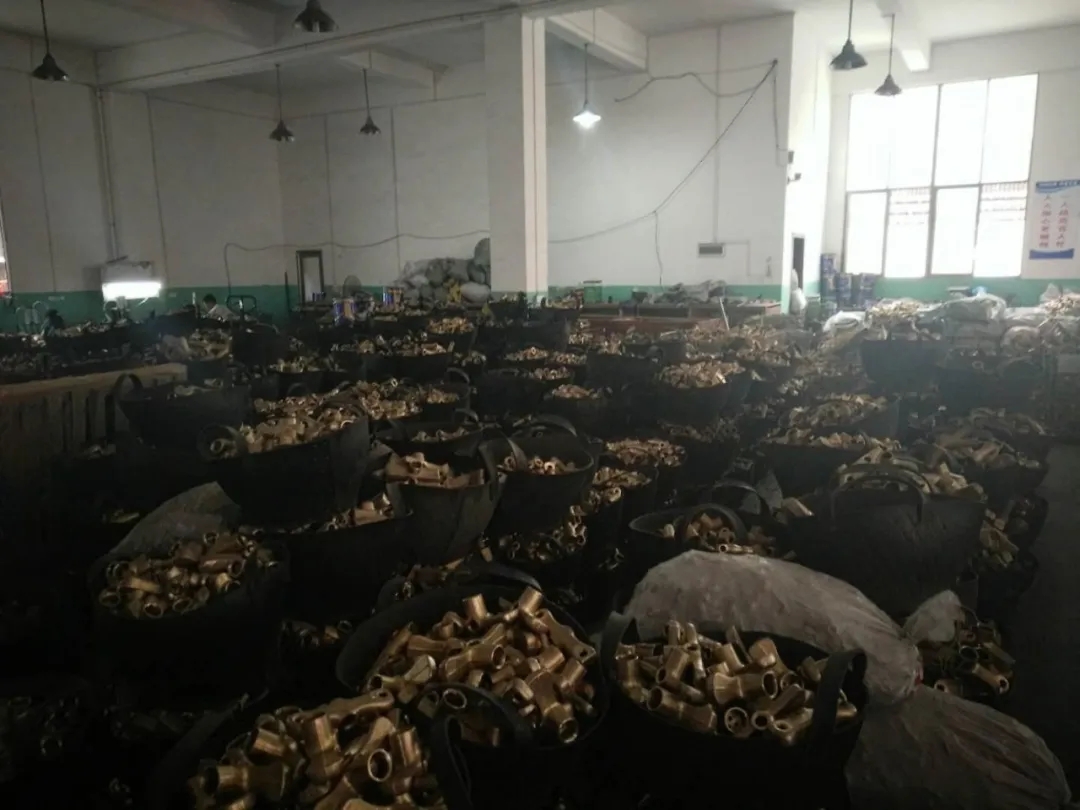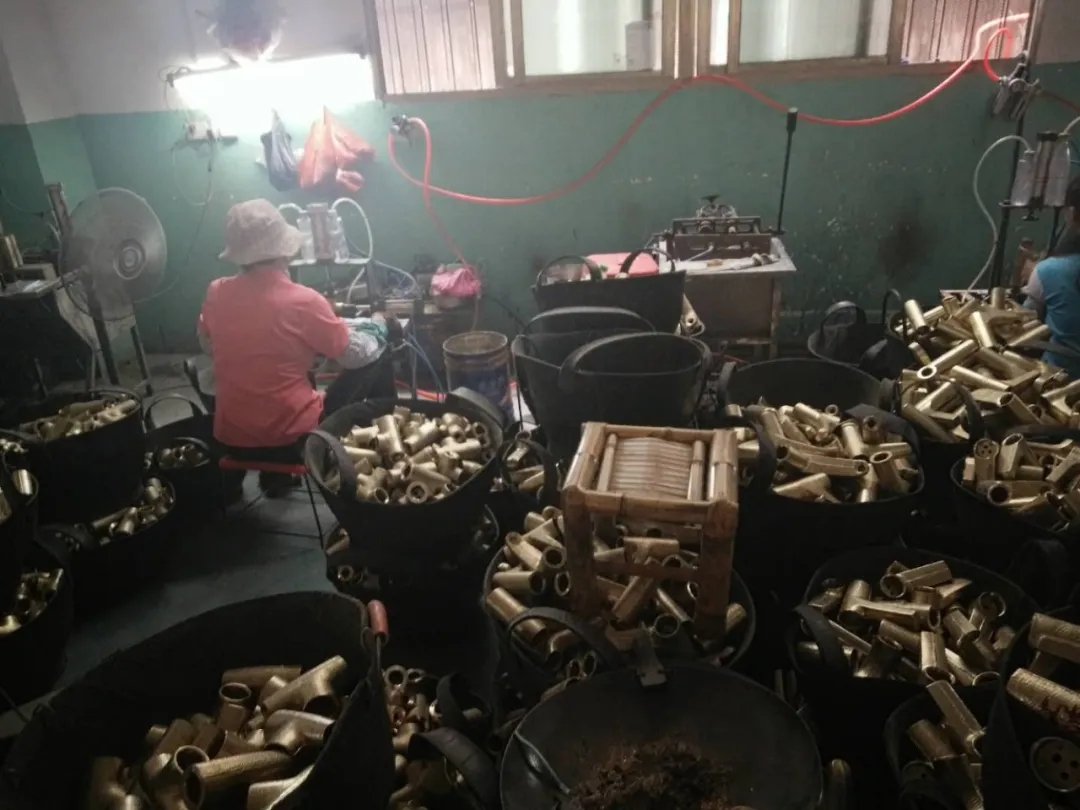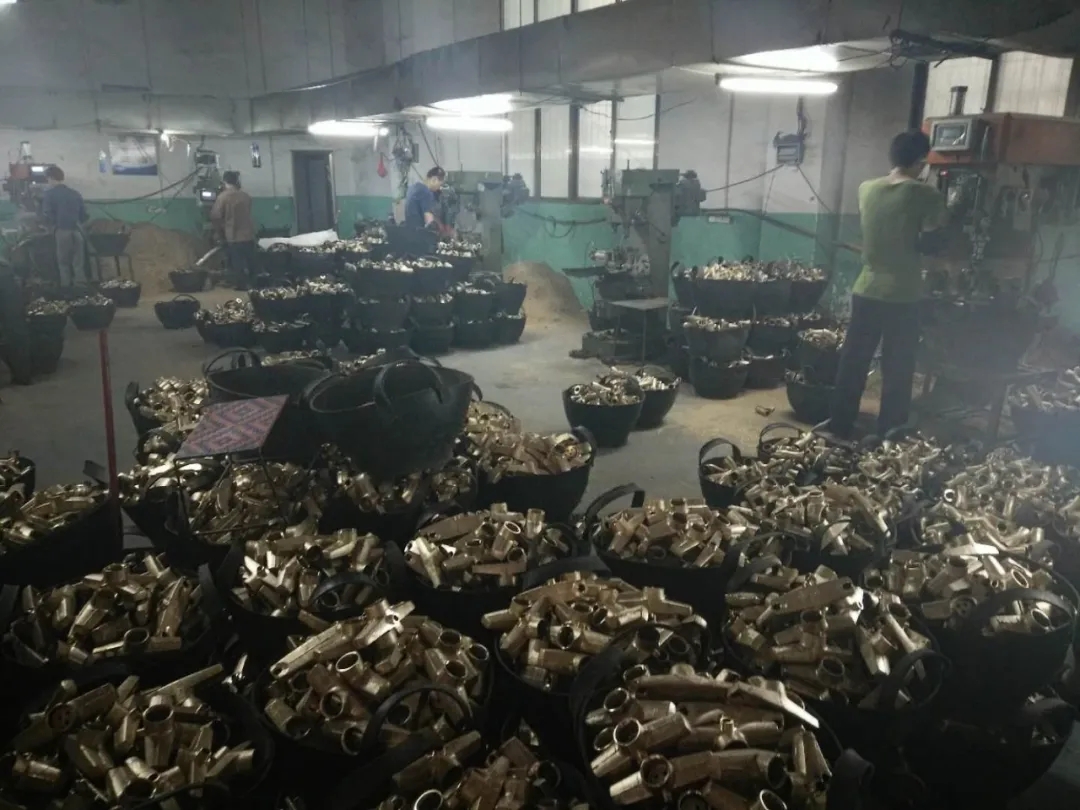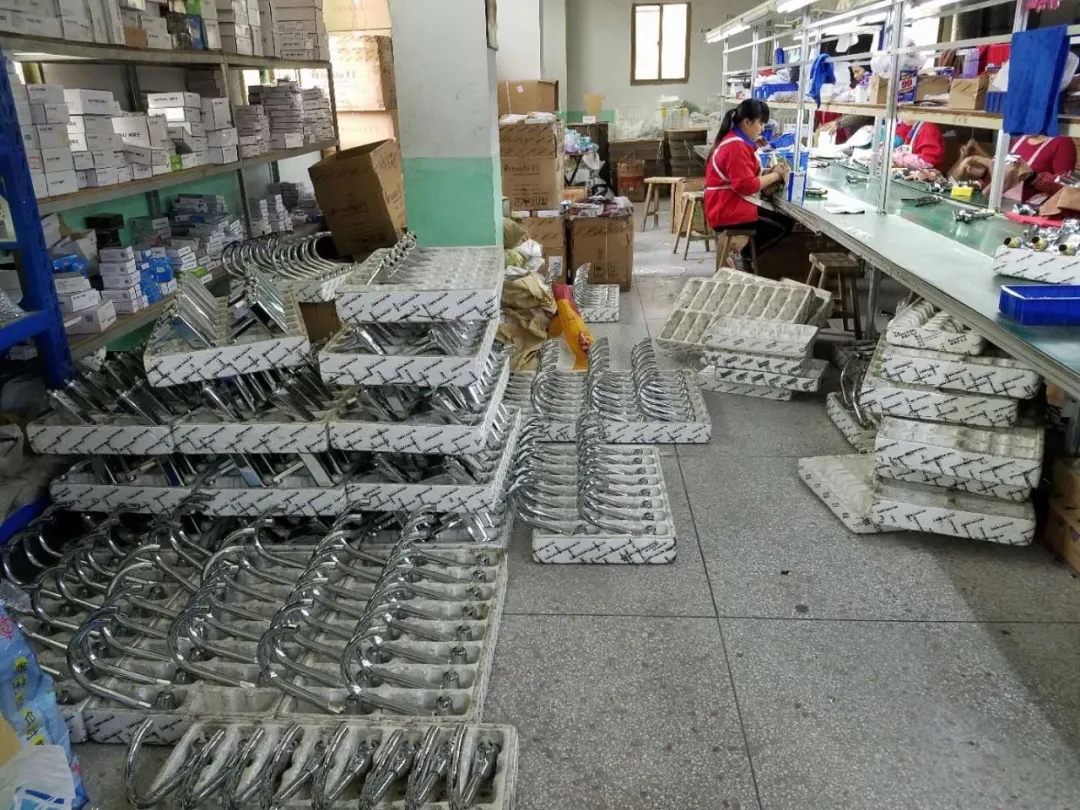Casting process of faucet
1. What is casting
“Usually refers to the method of making products with molten alloy materials, injecting liquid alloy into a pre-prepared mold, allowing it to cool and solidify, to obtain a blank or part with the required shape and weight.
2. Metal mold casting
Metal mold casting is also called hard mold casting. It is a casting method in which liquid metal is poured into metal molds to obtain castings. The mold is made of metal and can be used repeatedly (hundreds to thousands of times). The castings that can be produced by metal mold casting currently have certain restrictions in terms of weight and shape. For example, ferrous metals can only be castings with simple shapes; the weight of the castings cannot be too large; the wall thickness is also limited, and the wall thickness of the castings is smaller. Thick can not be cast.
3, sand casting
Sand casting is a traditional casting process that uses sand as the main modeling material to make molds. Because the molding materials used in sand casting are cheap and easy to obtain, and the molds are easy to manufacture, they can adapt to single-piece production, batch production and mass production of castings. For a long time, it has been the basic process in casting production.
4, gravity casting
refers to the process of injecting molten metal (copper alloy) into a mold under the action of the earth’s gravity, also known as metal casting. It is a modern technology for making hollow casting molds with heat-resistant alloy steel.
5. Casting copper alloy
The raw material used for faucet products is cast copper alloy, which has good casting properties, mechanical properties, corrosion resistance, and the casting has a fine structure and a compact structure. ZCuZn40P62 (ZHPb59-1) is selected for alloy grades according to GB/T 1176-1987 casting copper alloy technical conditions. The copper content is (58.0~63.0)%, which is the most ideal faucet casting material.
6. Brief description of the casting process of faucet
First, on the automatic hot box core shooter, a sand core is produced for spare use, and the copper alloy is smelted (smelting equipment resistance furnace). When the copper alloy reaches a certain molten state, chemical analysis is performed and the copper alloy test block is sampled and sent to the laboratory for chemical titration After analysis or spectroscopy, it is confirmed that the chemical composition of the copper alloy meets the requirements, and then pouring (the pouring equipment is a metal gravity casting machine). After cooling and solidification, the mold is opened and unloaded to clean the pouring riser, and after the copper water in the resistance furnace is completely poured , Self-inspect the cooled casting blanks and send them to the sand shaker drum for cleaning. The next step is the heat treatment (stress removal annealing) of the cast blank to eliminate the internal stress generated by the casting. Put the blank into the shot blasting machine for finishing to achieve a more ideal casting blank, and ensure that the inner cavity is free of molding sand, metal chips or other impurities. Then, the casting blank is fully enclosed, and the air is tested in the water to test the sealing of the shell and the sealing of the partition. Finally, it is classified into storage after quality inspection, analysis and inspection.



Third, the machining process of the faucet
1. What is machining
usually refers to the use of metal cutting machine tools such as turning, milling, drilling, planing, grinding, boring and other machine tools to perform various cutting processes on the workpiece, so that the workpiece can achieve the required dimensional accuracy, shape and position accuracy and meet the requirements of the drawing.
2, lathe
refers to a machine tool whose main movement is the rotation of the workpiece, and the movement of the turning tool is the feed movement to process the rotating surface. According to the purpose, it is divided into: instrument lathe, horizontal lathe, CNC lathe, etc.
3, milling machine
refers to a machine tool that mainly uses a milling cutter to machine various surfaces on a workpiece. Usually the rotation of the milling cutter is the main movement, and the movement of the workpiece (and) the milling cutter is the feed movement.
4. Drilling machine
refers to a machine tool that mainly uses a drill to make holes in a workpiece. Usually the rotation of the drill bit is the main movement, and the axial movement of the drill bit is the feed movement.
5. Brief description of the machining process of the faucet
In order to meet the frequent assembly and disassembly and repetitive batch processing of faucets, auxiliary fixtures and mold cutting tools must be manufactured to prepare for various processing requirements. First select the fixture tool and the workpiece for mold adjustment and trial processing. After the first piece is passed the inspection, the mass production is officially carried out. During the process, the operator conducts self-inspection, inspectors conduct inspections, and completes the inspection after completion, before the qualified products can flow to the next process. Perform pressure test inspection. On the pressure testing machine, the air pressure of 0.6Mpa is applied to the sealed shell, and the faucet shell is immersed in water to observe whether the sealing performance of each connection part and cavity of the shell meets the requirements. All qualified products undergo lead release treatment to eliminate trace lead elements in the inner cavity surface quality to make the faucet products more in line with the requirements of environmental protection indicators with low toxicity and less harm.
Fourth, the polishing process of the faucet
1. What is polishing
Polishing refers to the process of processing the surface of the faucet by the high-speed rotation of various grinding heads or linen (cloth) wheels of polishing machinery.
2, abrasive belt polishing grinder
refers to a grinding machine that uses a fast-moving belt for grinding.
3, surface grinder
refers to a grinder mainly used for grinding the surface of a workpiece.
4. Polishing machine
refers to a machine tool that uses the high-speed rotation of the linen (cloth) wheel to grind the surface of the workpiece to make it smooth and bright, and to increase the brightness and finish of the product.
5. Brief description of the polishing process of faucet
First prepare polishing tools, abrasives and abrasive belts, and do a good job of adjusting the machine. Carry out faucet rough grinding processing (No. 60 or No. 80) abrasive belt, remove the rough surface and potholes on the surface, and then use the (No. 180 or 240) abrasive belt for intermediate grinding, grinding the surface and trimming the contour; next The abrasive belt (No. 320 or No. 400) is ground three times to make the surface tend to have an ideal appearance, clear lines and well-balanced structure. Immediately after the No. 600 abrasive belt, it is finished to make the surface reach the ideal appearance contour, and it has been shaped into a real appearance entity. There are no obvious blisters and pore defects on the surface. Finally, 800 sand is processed to make the surface smooth and clean. Or polishing to make the surface smooth and bright, and the lines are smoother and smoother. During each process, the quality inspector will carry out the first article inspection, the process will be inspected, and the order will be transferred after the completion of the inspection and receipt, and strict control to ensure quality.
5. Foreign-related electroplating
1. What is electroplating
refers to the process in which the metal cations in the plating solution are reduced to simple metal elements under the action of the electron flow in the electrolysis process and deposited on the surface of the cathode plating parts.
2. Brief description of the electroplating process of faucet
The first is ultrasonic dewaxing, and cathode electrolysis of oil. Electrolytic degreasing, activation, coarsening, post-recovery, neutralization, surface conditioning, presoaking, sensitization, acceleration, positive electrolysis, negative electrolysis, water washing, neutralization, acid copper, activation, cleaning, nickel plating, recycling, Cleaning, chrome plating, etc. Copper plating can make the electroplated layer get a more dense structure, small defects and small pinholes on the surface of the faucet can be covered, and a satisfactory effect can be achieved. The effect of nickel plating improves the corrosion resistance of the faucet surface and can be highly polished. Chrome plating prevents corrosion and maintains brightness, improves surface hardness and improves wear resistance. The quality of the electroplating surface treatment is judged by a 24-hour acetic acid salt spray test (the test equipment is a salt spray tester) and a coating thickness gauge can be used to identify the thickness of various metal coatings. Generally speaking, the thickness of the coating is up to the standard, and the salt spray test can pass. The appearance of electroplating quality shall be fully inspected by quality inspection and recorded.
Six, the assembly of the faucet
1. What is assembly
Assembly is the process of connecting the processed faucet parts in a certain order and technology to form a complete set of faucet products, and to reliably realize the functions of product design.

2. The significance of assembly
A set of faucets is often composed of several parts. The assembly is in the final stage necessary for the manufacture of the product. The quality of the product (from product design, parts manufacturing to product assembly) is finally guaranteed and inspected through assembly. Therefore, assembly is a key link in determining product quality. Formulating a reasonable assembly process and adopting an effective assembly method that guarantees assembly accuracy is of great significance for ensuring and further improving product quality.
3. Brief description of faucet assembly process
First, equip various assembly tools and parts, and start to make connections, including detachable connections such as valve cores, mesh nozzles, etc., and non-detachable connections such as joints and water inlet feet. Install the valve core (porcelain core) and tighten the gland pin with a torque wrench or lock the ceramic core with a sleeve torque wrench. Install the water inlet foot or the water level and lock the hexagon nut with a 10mm hexagon wrench (the water inlet foot and the water level are pre-installed with a sealing “O” ring). The bathtub faucet is equipped with a water distributor switch. The next step is to test the water. First, clamp the faucet on the test bench according to the state of use, open the left and right inlet valves, open the valve core, rinse the faucet cavity in advance, and then close the valve core to install the net nozzle rubber pad and net nozzle , And use a wrench and other tools to tighten it lightly, no water seepage, do not use excessive force to lock, so as not to damage the parts. The next step is to perform a pressure test to check that there is no leakage on each sealing surface. The qualified product is transferred to the assembly line to install the pressure cap, handle, and cold and hot water marks. Finally, install the accessories and wipe the packaging and packing. During this process, the quality inspection carries out process inspection, operator self-inspection, and sampling inspection of finished products.
Seven, the factory inspection of the faucet (a person is responsible)
After the finished faucet products are put into the warehouse, the finished product inspector will conduct sampling inspection. The inspection items include: casting surface, threaded surface, appearance quality, assembly, marking, valve core sealing test, faucet sealing performance test and other items. Strictly implement the sampling plan And the principle of judgment. Check the quality of the last faucet product.
 iVIGA Tap Factory Supplier
iVIGA Tap Factory Supplier
